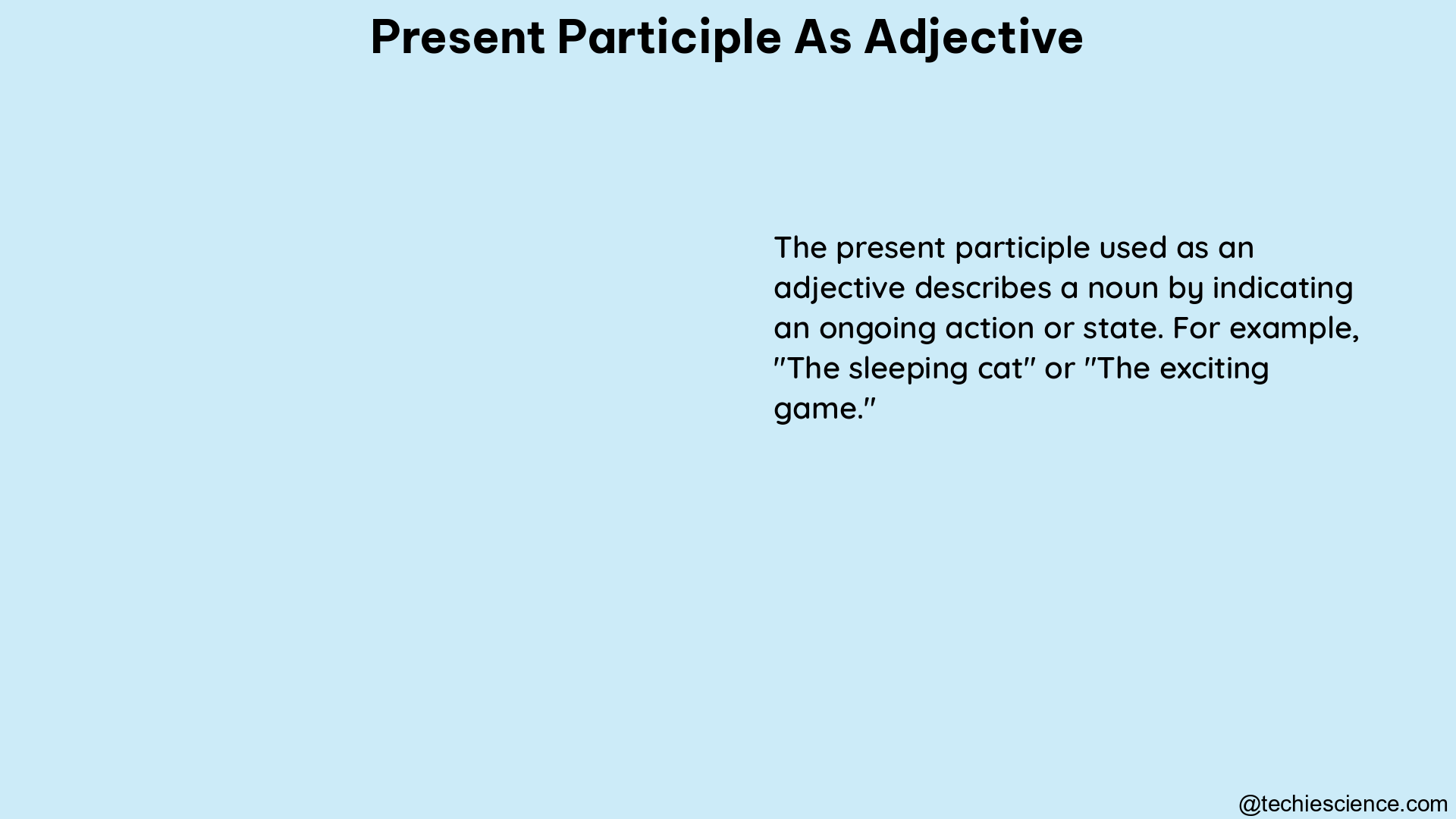The present participle is a versatile grammatical form that can be used as an adjective to describe nouns or pronouns. By adding the “-ing” suffix to the base form of a verb, you can create participle adjectives that express feelings, actions, or characteristics. This comprehensive guide will delve into the intricacies of using present participles as adjectives, providing you with a deep understanding and practical examples to master this essential English grammar concept.
Key Principles of Present Participle as Adjective
Formation
The present participle is formed by adding the “-ing” suffix to the base form of a verb. This transformed verb form can then be used as an adjective to describe a noun or pronoun.
Examples:
– The boring movie put me to sleep.
– She’s a fascinating person.
– The creeping vines covered the wall.
Usage
Present participles used as adjectives serve to describe the noun or pronoun they modify, often conveying a sense of feeling, action, or characteristic.
Examples:
– The intriguing mystery novel kept me up all night.
– The dazzling sunset was a sight to behold.
– The overwhelming workload caused the employee stress.
Participle Adjectives
Present participles can be used as adjectives to describe the person, thing, or situation that causes a particular feeling or experience.
Examples:
– It was such a boring flight. (The flight caused boredom)
– She’s an interesting woman. (She causes interest)
– The terrifying roller coaster left the riders shaken. (The roller coaster caused terror)
Participial Phrases
A participial phrase is a phrase that begins with a present participle and includes objects or modifiers. These phrases function as adjectives, providing additional description to the noun or pronoun.
Examples:
– Barking loudly, the dog wanted to come inside. (Describes the dog)
– Leaping through the woods, Josh landed his foot in a huge puddle of mud. (Describes Josh)
– Shimmering in the sunlight, the lake was a breathtaking sight. (Describes the lake)
Theoretical Explanation

Participles
Participles are verb forms that can be used as adjectives. There are two main types of participles:
- Present Participles: Formed with the “-ing” suffix, these describe the action or state of the noun or pronoun.
- Past Participles: Formed with “-ed”, “-en”, “-d”, “-t”, or “-n” endings, these describe the person or thing that experiences the action or feeling.
Present Participle as Adjective
The present participle, when used as an adjective, is the “-ing” form of a verb that modifies a noun or pronoun. It is important to distinguish this from a gerund, which is the “-ing” form used as a noun.
Examples:
– The approaching deadline hung over the heads of all the people in the office. (Describes the deadline)
– The leaping flames from the burning building presented the firefighters with a challenge. (Describes the flames)
– The captivating performance left the audience spellbound. (Describes the performance)
Advanced Examples with Specific Verbs
Boring
- The boring movie put me to sleep. (Describes the movie)
- I was talking to such a boring guy at the party. (Describes the guy)
- The boring lecture made it difficult to stay awake. (Describes the lecture)
Interesting
- She’s a really interesting woman. (Describes the woman)
- I read a really interesting book about history. (Describes the book)
- The interesting topic sparked a lively discussion in the classroom. (Describes the topic)
Frightening
- Many people find spiders frightening. (Describes spiders)
- My maths teacher at school was really frightening. (Describes the teacher)
- The frightening storm caused widespread damage in the area. (Describes the storm)
Comparison with Past Participles
Past Participles
Past participles are used to describe the person or thing that experiences the action or feeling, rather than the cause of the action or feeling.
Examples:
– I was bored during the flight. (Describes the speaker)
– She’s interested in history. (Describes the speaker)
– John’s frightened of spiders. (Describes John)
Exercises and Quizzes
Participle Adjectives Exercise 1
Identify the present participle used as an adjective in the following sentences:
- The twinkling stars lit up the night sky.
- The captivating performance left the audience in awe.
- The overwhelming workload caused the employee to feel stressed.
- The soothing music helped the baby fall asleep.
- The dazzling sunset was a sight to behold.
Participle Adjectives Exercise 2
Rewrite the following sentences, using a present participle as an adjective to describe the underlined noun or pronoun:
- The movie was very boring.
- The person is fascinating.
- The vines covered the wall.
- The deadline is approaching.
- The flames from the burning building presented a challenge.
Quiz: Present Participles
-
Which of the following is an example of a present participle used as an adjective?
a) The running child
b) The child ran quickly
c) The child’s running shoes
d) Both a) and c) -
In the sentence “The twinkling stars lit up the night sky,” the word “twinkling” is a:
a) Gerund
b) Past participle
c) Present participle
d) Infinitive -
Which of the following sentences correctly uses a present participle as an adjective?
a) The bored student fell asleep in class.
b) The student was boring the teacher with endless questions.
c) The boring lecture made it difficult to stay awake.
d) Both b) and c)
Answers:
1. d) Both a) and c)
2. c) Present participle
3. d) Both b) and c)
References:
- Perfect English Grammar: Participle Adjectives
- Lawless French: French Present Participle as an Adjective or Noun
- DAILY WRITING TIPS: Present Participle as Adjective

Hi! I am Bhabesh Sing. I have completed M.A in English, M.A in Vocal Music, and B.Ed. I am a creative writer. Currently, I am a Subject Matter Expert in English on this Platform.
Let’s connect through LinkedIn-https://www.linkedin.com/in/bhabesh-sing-660914ab